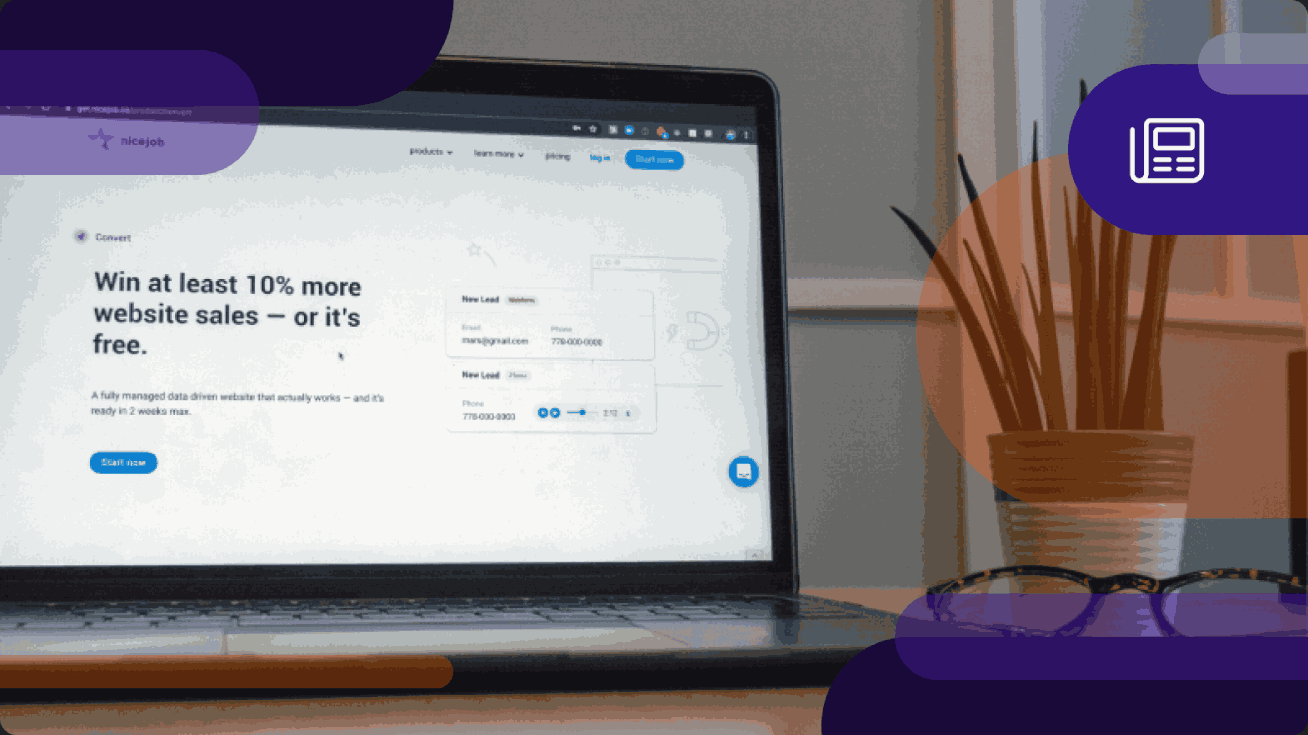5 Steps on How to Create a Small Business Website
Learn How to Make a Website for a Small Business from Wes McDowell on the NiceJob Podcast
Wes McDowell, from the podcast The Profitable Website, joined the NiceJob Podcast to share what he’s learned over the years about turning company websites into sales machines.
With a background in graphic design, Wes started creating websites for clients focusing on how cool they looked.
He quickly realized that he was falling into the trap many small business owners do when creating a website: He was missing the strategy behind the design.
After studying user experience and business psychology, Wes learned that while a website still needs to look nice, it also has to deliver the right message that inspires people to take action.
“Your website is a sales tool, not an art project.”
To complement NiceJob’s guide on how to build a lead generation website, Wes shares his tips for how a small business can improve their website to scale their company to new heights.
In this post, we summarize the season-three premiere of the NiceJob Podcast with Wes McDowell. Let’s do this!
5 Steps to Make a Small Business Website
There are five vital steps you must follow to craft a website that effectively turns visitors into customers:
- Develop a Clear Purpose for Your Website
- Write Benefit-Driven Copy
- Craft Eye-Catching Headlines
- Use Social Proof
- Create a Digestible Structure
Let’s dig into each of these steps and explain the essentials of having a website that drives leads for your small business.
1. Develop a Clear Purpose for Your Website
The very first step you need to take before creating or updating your website is to set a clear goal that you want your website to achieve.
According to Wes, the biggest question you can possibly ask is what your end goal is. What are you trying to achieve with your website?
Whether it’s to get people to book more appointments, sign up for an email newsletter or buy a product, you need to define the goal clearly as this will determine every action you take.
Without clarity at the top and having a goal as your guiding light, making copy, design and technical decisions will be like throwing a dart at a dartboard in the dark—you're just guessing.
2. Write Benefit-Driven Copy
Based on the goal you set for your website, the next step is to start writing the copy. This is a crucial step a lot of people get wrong—so don’t leave it for later.
Always write the copy and craft the messaging before you work on the layout.
There are a lot of tools to help you create a website for your business that make it easy for you to just choose a nice layout or template and start working from there.
Those sound great, but you’re going to end up shoehorning your copy to fit the pre-set design when it should be the other way around!
Your copy should dictate everything else, so always start with that.
Now, to write effective copy for your website, you must lead with benefits! How do you do that?
Put yourself in the position of your ideal customer to figure out what they need to hear to realize you’re their best option. Once you know what that is, use all your copy to prove your point.
The key here is that you need to make everything about your customer, not you.
So every time you talk about yourself or your company, whether it is your experience or qualifications, you need to find a way to translate it to what that means for your customer.
A quick trick to turn your strengths into value is to always ask, why is this important? And then make that a statement. Here’s an example:
Let’s say you have a lot of experience so you want to write something like: “We’ve been in business for 50 years.”
At this point you’re stating a strength but it doesn’t really convey any added value for your potential customers.
After asking yourself why 50 years in business is important, you may instead write, “We’ve been in business for 50 years, helping thousands of people just like you, and we can help you too.”
Now you’ve illustrated how your strength is valuable for your customer. They see themselves in your experience (“people just like you”) and see the relevance to them (“can help you too”).
To really hammer down your benefits, include a problem-solution section where you lay out the problems your ideal customer is likely to have and explain exactly how you can solve it. You can even leverage an AI content generator to assist you in writing the copy that speaks directly to your audience's needs. Tailor your message to resonate with their desires and concerns.
3. Craft Eye-Catching Headlines
Did you know that when someone gets to your website, it takes them less than five seconds to decide if they’re staying or going?
Just five seconds! So your headlines are crucial to your content strategy. If your copy is the line and your CTAs the sinker, think of your headlines as the hook (or at least the bait!).
Wes’ formula for success for headlines is to have one big headline as a bold statement—the big promise of your business. The goal of this line is to capture the attention of your visitors.
Then, have a subheadline underneath where you can be more specific in adding clarity to that big, bold statement. You can see this in action on our website:

4. Use Social Proof
Of course, social proof has to be part of this party.
What is social proof? Simply put, social proof is all about leveraging customer-generated content, like reviews, as part of your marketing strategy.
People like to see they’re part of a group. Knowing that others have gone before them eases the natural hesitation your potential customers have.
According to Wes, a great strategy to display social proof on your website revolves around first looking through your reviews to find one that’s really good.
What makes a review a really good one? Look for a review that talks about something most of your customers can identify with, like a common problem people have when they come to you.
A good review explains how this common problem wasn’t an issue with your company.
Once you pick out that one perfect review, put it on your website. Make it big and bold. Then surround it with your most recent reviews.
Remember, people like to know others have gone before them. This is how you show it.
Sharing customer reviews as stories is one of many examples of social proof to help your website sales skyrocket!
On the NiceJob website, for example, we utilize the NiceJob Stories widget to automatically share our best and most recent reviews.
You also see where the reviews live (e.g., Facebook, Google, etc.). This way, people can trust these are real reviews from real customers.

Another way you can include social proof is by displaying your overall ratings from different reviews sites.

We use our own Reviews widget to quickly show off to website visitors how many reviews we have and our overall rating from across different review sites.
Make sure you know which review sites to sign up on, like all of the available contractor review sites if, for instance, you’re a home-service provider, to maximize your review opportunities!
5. Create a Digestible Structure
Always keep in mind that people don’t like to read too much text.
When someone’s browsing through your website, they are really just scanning, trying to find the information they need as quickly as possible.
So the worst thing you can do is to have walls of text on your website. It's overwhelming and you’ll lose potential customers in the blink of an eye.
Instead, think about your content like trying to trick your kid to eat more veggies by hiding the broccoli under the cheese. Make your copy easy to swallow.
You can do this by playing with short paragraphs, subheadings and bullet points. Is there a key phrase you want them to read? Make it bold so it stands out!
This is what we mean by creating a digestible structure. Structure the content on your page like a newspaper article, or, if you learned the hamburger method in school, like a hamburger.
The buns are your intro and conclusion, the veggies your transitional points and the meat & cheese as your proverbial “bread & butter.”
You might not be writing an essay on a webpage about selling your business services, but the principle remains the same.
Your sales copy and your messaging need to coax your users in, grab their attention, offer supporting elements that demonstrate your point and deliver the point itself.
Mashing all of these elements into large paragraphs and rendering them indistinguishable from each other does nothing to help your visitors easily “digest” your website.
Increase Conversion Rates for Your Small Business Website
And there you have it!
Setting a clear goal, writing benefit-driven copy, crafting attention-grabbing headlines, sharing social proof and making content digestible are the five steps for an effective sales website.
For an easy way to present a strong website to your potential customers and increase your conversion rates of visitors to leads, check out Convert websites by NiceJob!
Our Convert websites are designed to get you a 10% higher conversion rate—or it’s free—guaranteed! This way you can focus on what you do best, running your business.




